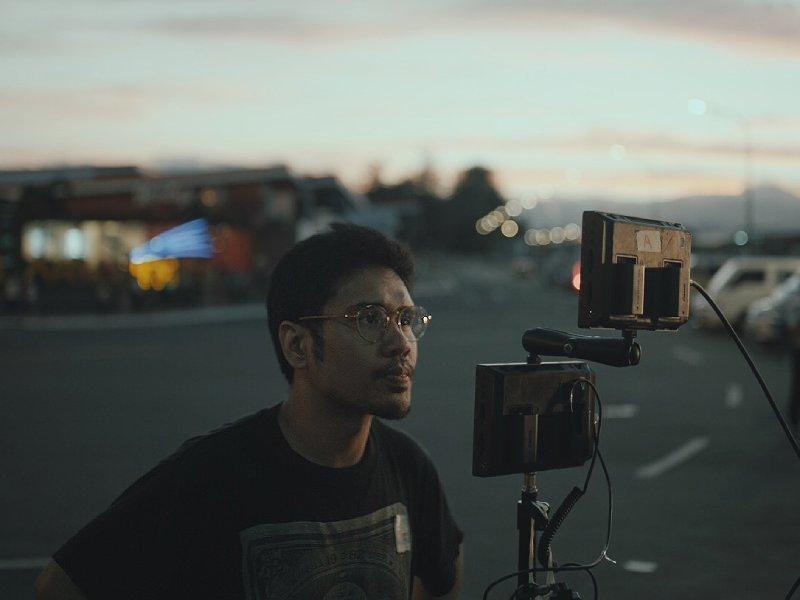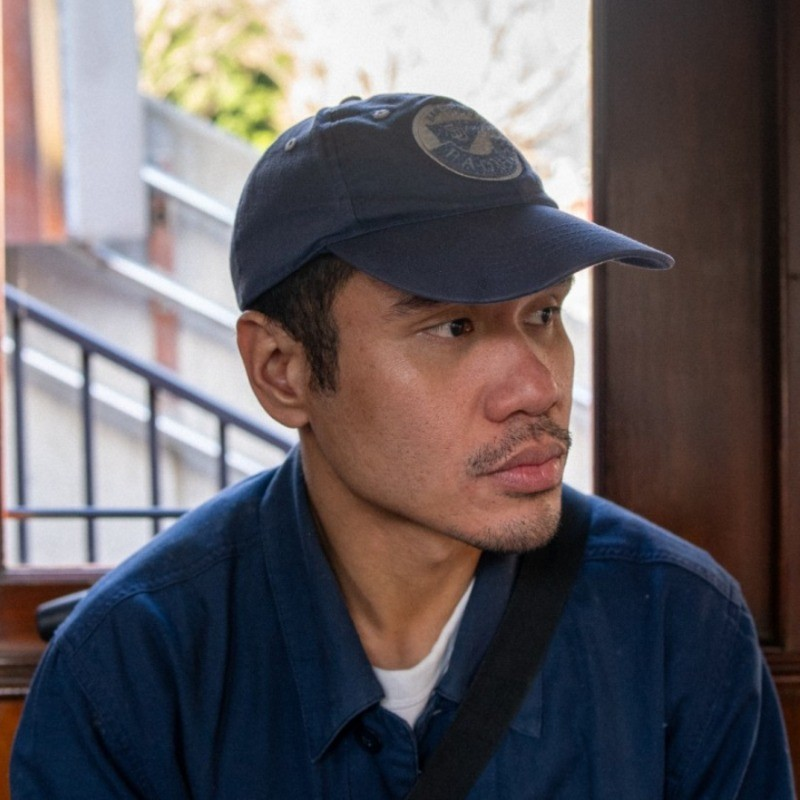Alec Figuracion is a designer who thinks in rhythm, structure, and sequence. Currently Senior Visual Designer at Lutron Electronics, he works at the intersection of motion, publication, and narrative systems, creating visual languages that move both conceptually and emotionally.
But his approach to design didn’t come from a traditional path. Before working with typography and systems, Alec trained as a filmmaker, an experience that sharpened his instinct for pacing, tone, and emotional clarity.
“I used to think I had to choose,” he says. “Film or design. Motion or print. But I’ve realized my work lives in the space between those things. That’s where I feel most at home.”
From Frame to Grid
Alec’s earliest training was in filmmaking, but design became the language where his instincts truly found form. His second feature, The Eternity Between Seconds, which he wrote, directed, and edited, was recognized at the CineFilipino Film Festival and screened internationally. Even then, it wasn’t plot or prestige that drew him in, but the quiet logic of pacing how emotion builds between transitions.
“I was more interested in rhythm than narrative,” he says. “How something feels when it lands quietly, not loudly.”
That sensitivity to timing became the throughline in his creative practice. What began in film editing evolved naturally into motion design, where type, sequence, and silence became tools of expression. Over time, this broadened into a hybrid visual language: typography that lingers, publications that breathe, and layouts that guide emotion through rhythm.
Design gave Alec a new kind of structure, one where ambiguity could live on the page and visual logic could shape meaning. He didn’t leave film behind; he brought its sensibilities with him, reimagined through design.
Designing With Time
At Lutron, Alec leads motion and visual design across product and brand platforms. Outside work, he runs a multidisciplinary practice focused on type, editorial, animation, and branding, often in collaboration with cultural institutions.
A key moment came through a project with Emerging Islands, where Alec designed a photography folio for National Geographic Explorers; more than a book, it became a paced visual narrative shaped by rhythm and restraint.
“I approached it like I would edit a film,” he says. “The page turns were cut. Each spread had to breathe. It needed silence, rhythm, and atmosphere.”
Though rooted in design, the piece reflects his instinct for timing and tone. It reads less like a catalog and more like a slow film, a design that doesn’t just present content but shapes how it’s felt.
Learning to Work Softly
Alec deepened his hybrid practice during his MFA in Graphic Design at RISD, where his thesis, Soft Procedures, used softness in both form and intention as a method for visual storytelling.
At its center was a design-driven video essay about his grandmother, combining split screens, archival photos, and studio footage. Rather than resolving narrative arcs, the piece explored how visual composition could hold memory, blur, and incompleteness as structure.
“I didn’t want to resolve things,” Alec says. “I wanted to hold the uncertainty. Let the viewer linger.”
That same approach, designing with ambiguity, pacing, and restraint, now shapes everything he creates, from motion sequences to editorial systems. He sees ambiguity not as something to fix, but as something to design with.
Process Over Product
Alec’s projects rarely begin with a fixed concept. “Most of the time, I don’t know what I’m making at first,” he says. “I start by collecting, cutting, and layering; eventually, something starts to take shape.”
He moves fluidly between digital and physical: pinning up drafts, cutting paper, and shifting things by hand. This tactile approach allows structure to emerge through iteration, a process shaped more by visual intuition than rigid planning.
Even when working on a book, Alec treats white space like time. “It’s not just about the content; it’s about how long someone stays with it. What comes after silence?”
It’s this sensitivity to rhythm, space, and user pacing that defines his work across media. Meant not just to be consumed, but to be experienced slowly.
Designing in the Middle
There were times Alec wondered if his path made sense. “One week I’d be animating, the next designing books. Some people told me to specialize. Pick a side.”
But the in-betweenness became a strength. His motion work carries the nuance of storytelling. His publications unfold with intention. His identity as a designer doesn’t reject his past in film; it incorporates its sensibilities into a visual design practice grounded in systems, rhythm, and tone.
This isn’t generalism for the sake of it. It’s a specific kind of narrative design that is fluid across formats but focused in intention.
And across everything, one thing remains constant: story first.
That principle allows Alec to shift between mediums, designing a motion sequence for a tech brand one month and then crafting a publication for a cultural project the next, without losing coherence. Each project becomes a container for tone and structure, shaped by rhythm and guided by how people feel, absorb, and remember.
On Collaboration and Listening
Alec’s work often feels personal, but his approach to collaboration is deeply open, treating each project as a shared narrative shaped through typography, pacing, and dialogue.
“A lot of what I do comes down to timing,” he says. “And timing is relational; you’re responding to people, to material, to context.”
He often sees the reader or viewer as a collaborator, too. “Design is a structure you leave behind. Someone else completes it.”
Even in motion-heavy or system-driven projects, Alec builds in space to feel, to pause, and to interpret. It’s an approach that prioritizes resonance over spectacle and clarity over control.
Building Narrative Systems
Alec’s design approach is structured but flexible, building systems that behave like stories: paced, intentional, and emotionally clear.
“Designing a system isn’t just about consistency,” he says. “It’s about rhythm, logic, and how each element contributes to a larger feeling.”
In motion, he uses timing and restraint to shape how ideas unfold. In editorial work, he sequences spreads to guide how a reader moves through space. In branding, he designs the tone of how a visual voice can stretch, soften, or sharpen depending on context.
Across all formats, he designs for clarity but always makes room for texture, softness, and space.
Even when working with clients, Alec keeps one question in mind: How will this be experienced over time? That question guides everything from typography choices to animation pacing. The result isn’t just practical; it’s effective. It stays with you.
Toward the Next Sequence
Image by Alec Figuracion on Vimeo
Right now, Alec is focused on designing title sequences and complete identity systems projects where pacing, typography, and structure work together to shape how stories are felt. He’s also continuing to create books that explore the space between image and text, stillness and sequence.
In the long run, he envisions building a studio in the Philippines, part design lab and part production house, “A place where motion and print sit side by side,” he says. “Where you don’t have to pick one language to speak in.”
Some designers talk about branding. Others talk about systems. Alec Figuracion’s discussions about time. Emotion. Atmosphere. His work doesn’t shout. It lingers.
And when you spend time with it, it teaches you something about how we wait, how we remember, and how stories can unfold quietly through design that feels as much as it functions.
Explore more at alecfiguracion.com.
About the Author
Isabel Reyes is a writer, editor, and researcher interested in the poetics of process, cross-disciplinary storytelling, and the quiet tension between form and feeling. Her work often explores how artists and designers build meaning across mediums, especially when the boundaries between them blur. She has contributed to independent publications, design journals, and exhibition texts across Southeast Asia and the U.S. She is currently working on a series of essays about memory, slowness, and structure in contemporary creative practices. She lives between Manila and Providence.


